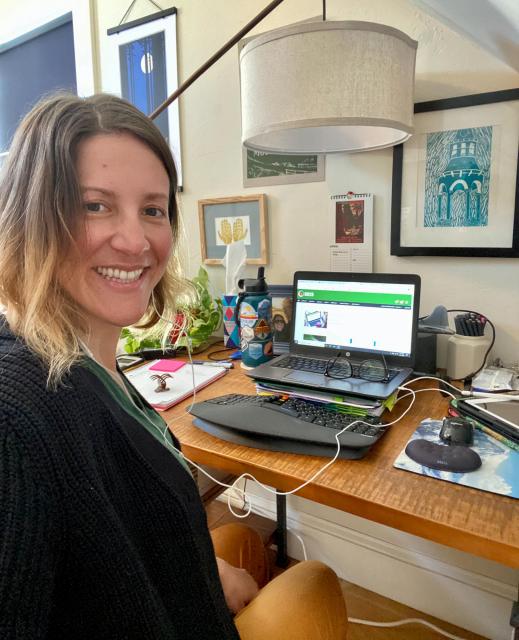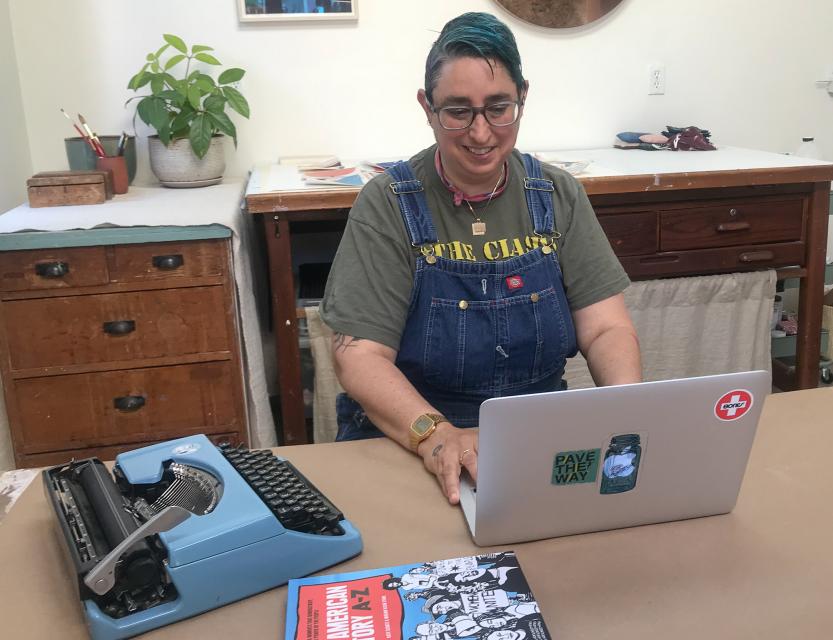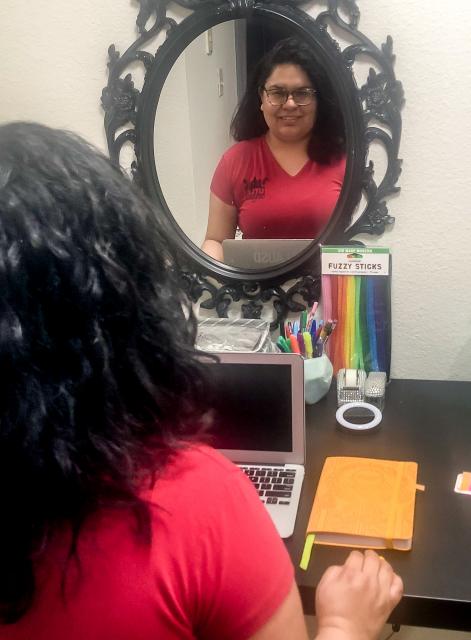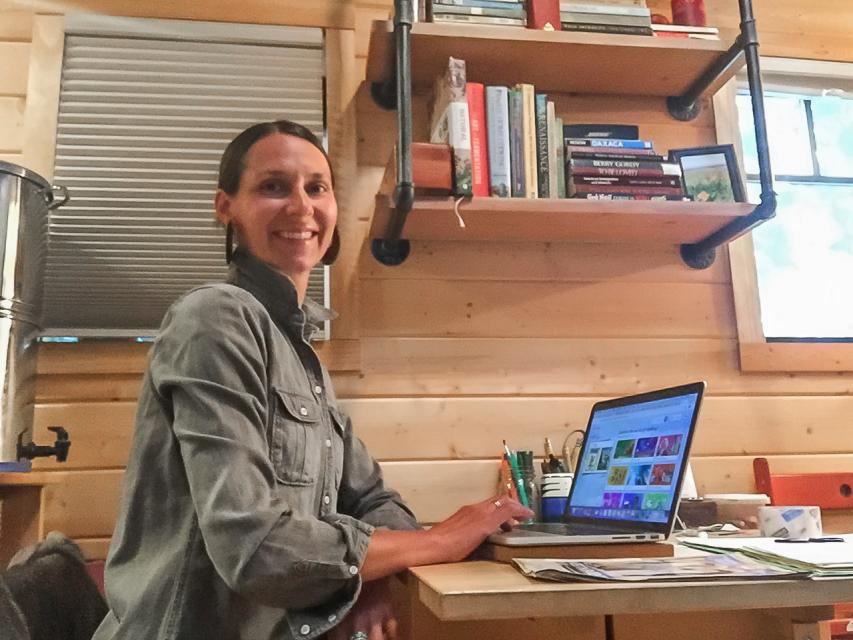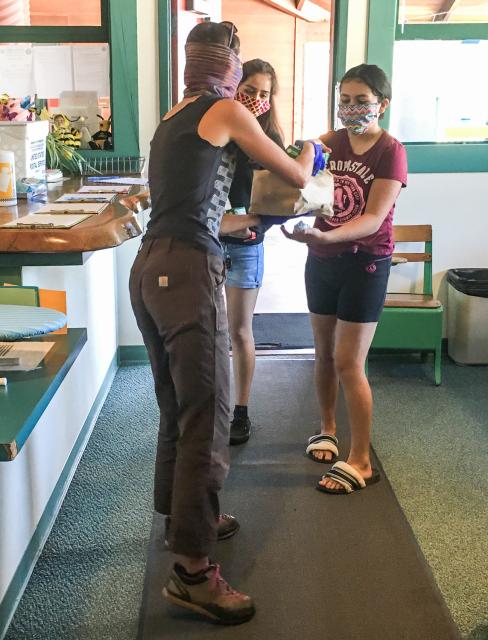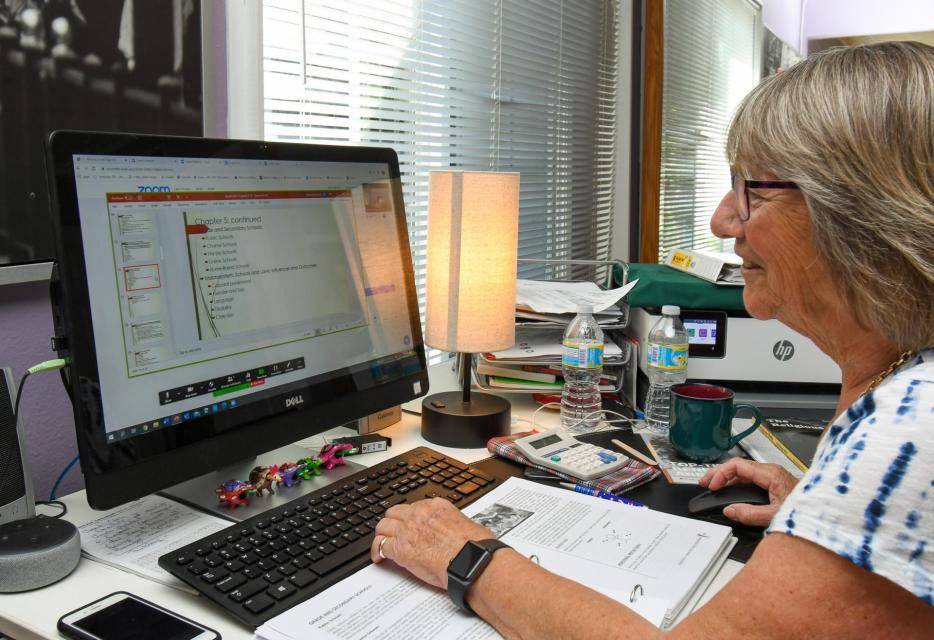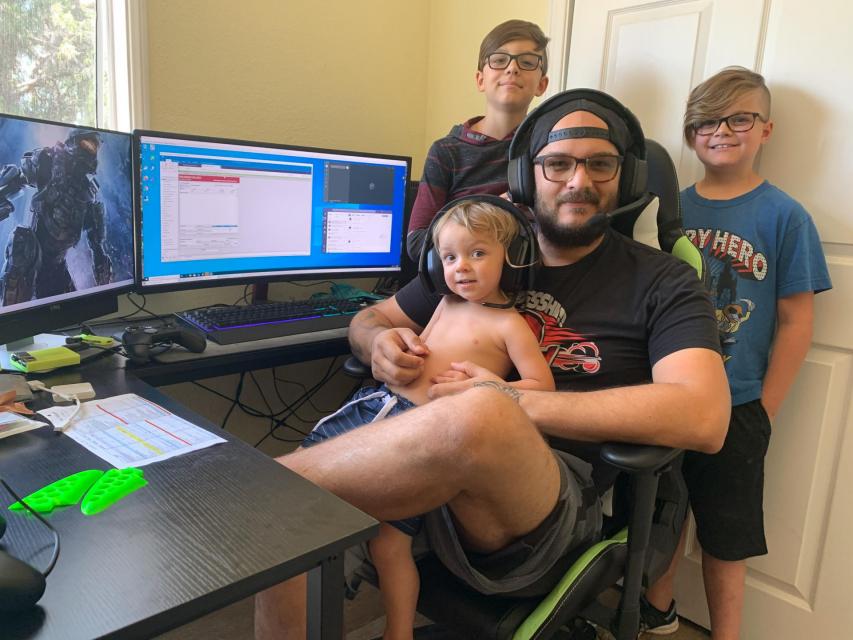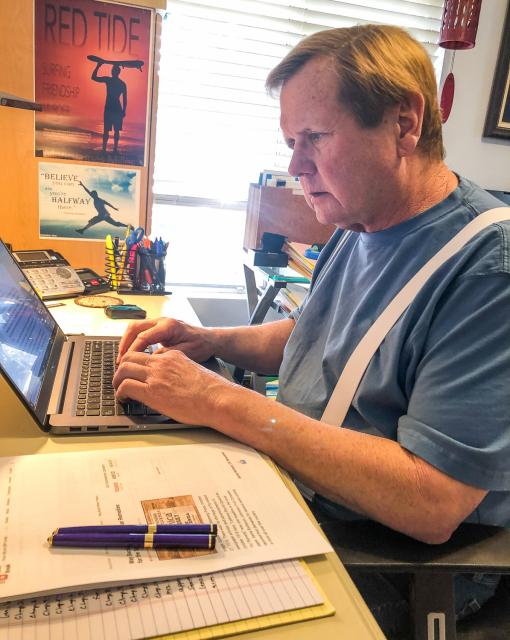Since schools closed due to the COVID-19 pandemic, and instruction moved online, Jessica Hoffschneider, a resource special education teacher at Soquel High, has been busy. A site representative for the Greater Santa Cruz Federation of Teachers, she spends her days trying her best to help her students with mild to moderate disabilities.
Even more than other teachers, special education teachers deliver services where face-to-face instruction is critical, and now they have no clear guidance at a federal or state level other than to do the best they can.
“The first week we tried to do group video meetings, but participation was low,” she said. “A big part of my job is trying to help them with their general ed classes, and it was not feasible to help seven different students with seven different assignments at once.”
Hoffschneider now meets one-on-one with her students from a half hour to an hour. She often has to call or text to remind them, and she is responding to many more emails a day since parents are understandably trying to make sense of what is going on. Since many teachers are new to using online platforms, sometimes the instructions are not posted with the assignment and a lot of time is taken up just trying to understand what parents need to do.
Special education teachers have been doing Individualized Education Plans (IEPs) with families through video calls, and Hoffschneider says that’s taken some getting used to.
“At first it was awkward sitting in your house, and you can see in their homes,” she said. “But one thing about this pandemic is people are more cooperative and friendlier like we’re all in this together, and after the first two, it just felt like this was normal.”
Hoffschneider works with students a lot on their writing and reading, and she’s thankful that most of her students have or have borrowed laptops and the hotspots the district has gotten for them are working – not the case everywhere. A concern is not overloading the students with work from all their different teachers, Hoffschneider says.
“We’re trying to engage them all at some level,” she said. “But many students are taking care of younger siblings, so it’s important for teachers to cut back a little. How can a 16-year-old who babysits three younger siblings for six hours a day get on a computer for four hours?”
Hoffschneider appreciates her union’s support and responsiveness, and she says meetings of the team between administration and labor — Partnership Labor and Administration — have gone well and administrators have been open to feedback.
• • •
Not overloading students was also a concern for teachers at Berkeley High School. Miriam Klein Stahl, an artist who co-founded the Arts and Humanities Academy there, saw her daughter, an organized and conscientious seventh grader, in tears over the amount of work she was getting the first few weeks, as her teachers didn’t know what others were assigning. To avoid this, Stahl and her colleagues are in touch often, and on Mondays they have a spreadsheet showing the work they plan to assign. She says they try to make the assignments flexible.
“I’ve been assigning these books, and students can spend hours and hours or just sort of get it done,” Stahl said. “Kids that love doing art are pretty stoked to be in my office hours, and I’m making goofy YouTube videos of stuff they can watch.”
Stahl and her colleagues were planning a big interdisciplinary project for their students around COVID-19, and she says they still might do it, but for now the students would like to just stick with their regular work. The teachers in the small art school do video check-ins with students twice a week for each grade level. Stahl says about 40 to 50 students show up and are able to see their teachers and one another.
Stahl, a member of the Berkeley Federation of Teachers, and the illustrator of the Rad Women series with writer Kate Schatz, never imagined her teaching career looking like this.
“It’s just weird,” she said. “I have office hours for kids to pop in and get help and you’re talking to a kid and they’re in their bedroom, and it’s like, ‘Could you get out of your pajamas, please?’”
Stahl says she can pick up technology fairly easily, and the most stressful thing about going online has been not being able to reach about a quarter of her students.
“We’re very close, tight community, so to not hear from some of our students who we know have some struggles like housing insecurity or food insecurity is hard,” she said. “It’s been a lot of organizing trying to make sure students on free and reduced lunch know how to pick up food and that they have access to a computer, so we’ve been getting them Chromebooks.”
• • •
Like Stahl, Xavier Santos doesn’t find using technology a struggle. He wants his students in the third grade gifted class at Caroldale Learning Community in Los Angeles, to be comfortable with it.
“Since day one, I taught my kids how to be computer literate,” he said. “it’s a huge priority to use different tech platforms.”
Now Santos spends lots of time online himself, researching different platforms he can use with his students. He joined a Facebook Group, Teaching During COVID-19, where teachers from all over share ideas and suggestions about what worked for them. When Santos wanted to assign a book, The Miraculous Journey of Edward Tulane, for the whole class to read together chapter by chapter, someone in the Facebook group suggested a platform where Santos is able to make comments on the text that students can respond to.
Santos says he often gets only a few hours of sleep a night trying to find the most effective ways to teach his students, but it’s paying off. He’s never had all 24 of his students come to class, but an astonishing 22 or 23 show up online.
He also holds regular Spirit Days and sends parents an advance message through Class Dojo with a themed picture of himself to motivate kids to dress up similarly. Santos has held about a dozen so far, including Unicorn Spirit Day (with accompanying unicorn-themed lessons) and Star Wars Spirit Day, where the kids trained as a Jedi Padawan by doing aerobics.
Santos, also a member of United Teachers Los Angeles, has personal reasons for wanting his students to be comfortable with technology.
“My parents came over from the Philippines, and they were both professionals,” he said. “My mother was a corporate accountant and when things started to go over to computers, she was always very anxious about technology. I’m 43, so my generation is able to see the value of using technology as a tool, and I want my students to know how to access it as a tool.”
• • •
English teacher Erika Alvarez also hasn’t had a problem switching her classes at VAPA Legacy High School in Los Angeles to an online platform. Alvarez had already put a lot of classes online because so many of her students lacked basic necessities.
“We’re starved from the inside,” she said. “We’re on the southside of L.A. with predominantly brown and black communities, and we don’t always have pens and paper, and I can’t make enough copies.”
Due to these limitations, Alvarez and a colleague created a curriculum on a platform called Schoology, so she already had that in place when the pandemic hit.
But, like Stahl, she worries about the students not showing up for her online classes.
“It runs the gamut,” she said. “Some of them have actively reached out for emotional support and from some it’s been radio silence, and that’s hard when we don’t know what’s happening and we don’t know what their home life is like or if they’re being neglected.”
Alvarez says she understands why some students aren’t able to be participate in class now.
“Some are watching other kids in the family while their parents are going to work,” she said. “A lot of them are English language learners trying to help support the family and can’t come to six classes online.”
Alvarez says colleagues have been supportive of one another as they try to figure out what to do during a stressful and confusing time.
“LAUSD is like the Wild West,” she said. “The administration has its own ideas and the principal has his own ideas and it’s like they’re all contradicting each other.”
Alvarez thinks working together to organize the union’s successful strike last year has helped encourage people to fight unfair demands. The district has been asking for things like seeing a daily lesson plan and teachers keeping the same schedule online they had in the classroom.
“Our district is micromanaging us, and they want us to defend the fact we’re getting a paycheck,” she said. “The way I look at it nobody questions if a football player or basketball player deserves to make their millions, but working class teachers get nothing and turn it into magic.”
Her union, United Teachers Los Angeles, has been helpful in clarifying expectations of what members need to do, she says.
“UTLA came in and said, ‘This is reasonable, and this is not reasonable,’” she said. “We get weekly updates from our president, Alex Caputo Pearl. It’s a godsend to know UTLA is there to organize the teachers and enforce the contract.”
• • •
On a recent Tuesday morning, Kaitlin Kmec, president of the Horicon Elementary Federation of Teachers, AFT Local 4415, had a Zoom meeting with the 16 students in her first and second grade classroom. In their previous meeting about 10 of the 16 were able to show up. On this morning, though, the internet was unstable due to the windy conditions. Kmec changed the time of her meeting and went down to the school, which has a better connection, but only six of her students were able to join.
This happens a lot in the rural Sonoma County’s Horicon Elementary School District, one of California’s smallest, with a TK-8 campus of about 60 students. Not only is the internet connection not strong enough for many of the students, cell phone service is spotty as well. Verizon is the only option, Kmec says. Satellite internet may work better in some areas — but it’s outside many families’ price range.
“It’s been really challenging,” said Kmec, who was at the school to distribute food to about half of the school’s families. “Many of our students don’t have internet, or they do, but the data isn’t strong enough, or there’s not a stable enough connection to watch videos or have Zoom meetings, or some had to cancel because of financial reasons.”
Every student got a paper packet of work at the beginning of the lockdown, Kmec says, and they all have devices. The district is in the process of getting hotspots, but they still don’t know if hotspots will work. There are some in Gualala, but that’s a 15- to 40-minute drive for some families, and for a few that isn’t really feasible.
“One of my first-graders has no internet, and she has three younger siblings,” Kmec said. “It’s not an option to put four kids in the car so the older sister can sit in the car and use the internet.”
Things seem to change day to day, Kmec says. Working with younger kids, she is trying to address parents’ worries, whereas teachers in the older grades are trying to talk with the kids directly to see how they can help. Along with the food distribution, some people are sewing fabric masks for staff and families.
Kmec says they have weekly staff meetings and teachers feel frustrated about the inability to reach some of their students.
“The thing that feels important is that people recognize unless we’re able to get the internet situation figured out, it’s going to be an incredible hardship on our students if distance learning goes on,” she said. “It’s not their fault and it’s not the teachers’ fault — it’s nobody’s fault.”
— By Emily Wilson, CFT Reporter

